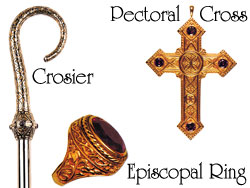Ring, pectoral cross and crosier are gifts from archdiocesan clergy

Archdiocesan clergy will welcome Archbishop Joseph W. Tobin as the new shepherd of Catholics in central and southern Indiana with the gifts of an episcopal ring, pectoral cross and crosier.
By Mary Ann Garber
Whenever Archbishop Joseph W. Tobin sees the episcopal ring on his right hand, places the pectoral cross around his neck or holds his crosier, he will be reminded of the generosity of the archdiocesan priests and deacons who presented them to him as gifts for his Dec. 3 installation as the new spiritual leader of the Archdiocese of Indianapolis.
Archbishop Tobin’s new pontifical insignia will be blessed during a solemn evening prayer service with archdiocesan priests, deacons and their wives, men and women religious, parish life coordinators, visiting priests and other guests on Dec. 2 at SS. Peter and Paul Cathedral in Indianapolis.
He will formally receive his episcopal ring, pectoral cross and crosier during his installation Mass the next day.
They will be “a lasting reminder of God’s blessings to us in our new shepherd,” Father Wilfred “Sonny” Day said, “… on this auspicious occasion.”
Father Day, pastor of St. John the Baptist Parish in Starlight and dean of the New Albany Deanery, represented the clergy on the archdiocese’s installation planning committee.
“In joyful anticipation of the installation of our new archbishop … and to mark the significance and gratitude of this moment,” Father Day said, members of the archdiocesan presbyterate donated $10,000 to purchase the gold-plated pontifical insignia as well as an additional $1,000 donation that Archbishop Tobin designated for Holy Family Shelter in Indianapolis.
The episcopal ring is decorated with crosses on the band, which holds a large amethyst.
It is a symbol of the bishop’s fidelity to, and nuptial bond with, the Church, his spouse. The ring signifies the bishop’s symbolic marriage to the Church and Christ, and is usually made of gold with an amethyst gemstone. It was first used as an official part of the bishop’s insignia during the early seventh century.
The large pectoral cross is adorned with four amethysts that accent its elegant design.
It is worn over the breast, or pectus, and if the bishop is wearing a black suit with his Roman collar it is usually placed in the shirt’s breast pocket with the chain showing.
The ornate crosier, or bishop’s staff, has an intricate Celtic filigree pattern to represent the archbishop’s Irish heritage.
It is adorned with cloisonné fire enamel cabouchons, which are shaped and rounded rather than faceted gemstones.
The pastoral staff is conferred on bishops and abbots during their installation as a sign of their office.
As is the custom in the Western Church, the top of the bishop’s staff is curved to remind him of a shepherd’s crook and his pastoral duties for the spiritual care of people entrusted to him. It is a sign of the bishop’s responsibility to keep watch over his entire flock.
Crosiers that date back to as early as the fourth century have been discovered in catacombs.
By the time of the Council of Toledo in 633, the crosier is mentioned as a liturgical implement.
Along with the archbishop’s new miter and vestments, the episcopal ring, pectoral cross and crosier are signs of the Order of Bishops. †
